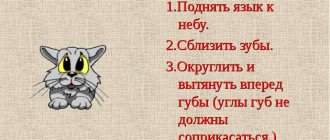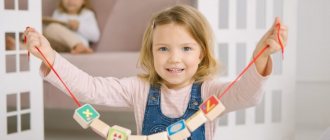The baby is growing quickly, chirping, and his babbling brings joy to his parents. But if your child is five years old, and his speech is understandable only to you, urgently start working on sound pronunciation. How to teach a child to pronounce the letter L at home without the help of a speech therapist? Games and special exercises will help you with this.
Why doesn't the child pronounce [l]?
Usually, by the age of 5-6 years, children pronounce almost all sounds. But quite often you can find children (and adults) whose pronunciation of the sounds [l] and [l'] is impaired. Moreover, producing a solid sound is difficult.
The reasons for incorrect pronunciation are different. Often this is the result of parents lisping with the baby, repeating words after the baby, and the desire to “chat in the child’s language.” This problem is also relevant in bilingual families where Russian is not their native language. Of course, if the parents themselves do not pronounce certain sounds, then their children will speak the same way.
There may also be physiological factors - problems with hearing, with proper breathing, the structure of the articulatory apparatus. Very often, a child does not pronounce [l] due to a short frenulum of the tongue, but with the help of special exercises it can be stretched (and not cut, as was done before).
By the way, parents’ request to teach their child to “pronounce the letter “L” is not entirely correct. We pronounce sounds and use letters to designate them when writing.
Difficulty pronouncing the sound [L]
Incorrect pronunciation of the sounds [l] and [l'], their omission in speech are designated by the term lambdacism.
Types of lambdacism:
- bilabial, when the sound is pronounced only with the lips and instead of “l” the result is “u” (“uampa” instead of “lamp”);
- nasal, in which, due to the incorrect position of the tongue, the air flow rushes into the nose and [l] sounds like [ng] (“ngampa”);
- interdental – if the tip of the tongue is between the teeth;
- the sound in speech is omitted (“ampa”).
Replacing hard [l] with other sounds is called paralambdacisism. These include:
- replacement with [g] - “gastochka” (“swallow”), “guna” (“moon”);
- replacement with [v] - “mavysh” (“baby”), “yabvoko” (“apple”);
- replacement with [d] - “doshad” (“horse”), “dyzhi” (“skis”);
- replacing with [j] - “yomtik” (“slice”);
- replacement with [u] - “usichka” (“chanterelle”);
- a situation when a child softens the sound by saying [l'] - “lampa” (“lamp”).
These pronunciation deficiencies can be corrected by doing simple, entertaining exercises every day.
What should parents do?
To successfully correct and teach the correct pronunciation of sounds, it is necessary to calculate the causative factor. A consultation with a speech therapist and, if necessary, a dentist will help you understand this. It is these specialists who can assess the condition of the tongue frenulum, the development of the speech apparatus, phonetic hearing and identify the problem of throat pronunciation.
On an individual basis, taking into account the complexity of the problem, its cause and the presence of additional circumstances, an individual treatment and correction plan is drawn up. The main thing is that parents must understand that success largely depends on the work of specialists and repetition of material at home.
[l] and [l']: we speak correctly
- They smiled broadly, teeth clenched.
- They opened their mouth slightly.
- The edge of the tongue rested against the gap between the teeth, or pressed it against the alveoli, or pressed it on the upper teeth. The sides of the tongue should not touch the teeth.
- The air comes out through the holes formed at the edges of the tongue with force and pressure.
It’s easier to give a child [l] from the following position: smile, teeth in a fence. Lightly biting the tip of the tongue, we begin to hum like an airplane: “L-l-l.” The baby should hear what sound he makes. Gradually move your tongue to the desired position - behind the upper teeth.
Tongue Twisters
A set of small speeches, rhymes and tongue twisters is one of the main elements of the technique. As tongue twisters, you can use the well-known “The Greek rode across the river...” or “Karl stole corals from Clara.” Or, together with your child, learn and recite poems aloud to practice the letter “r”: “Fish, saffron milk cap, lynx, fisherman, Rainbow, rocket, cancer. No, not cancer. Then a daisy, a fisherman, a gun, a shirt, maybe a frame or a handle? No. Are you giving up? It's Zhuchka! She sits under the table and growls” or “l”: “The milk ran away, ran away, ran away. I caught it with difficulty, Being a mistress is not easy!” or “Grandfather planted an onion, grew a forelock, his grandson saw the onion, and tore off the forelock. An amazing thing: Tears are falling from my grandson!”
Articulation gymnastics at home
To teach a child to pronounce the sound “L”, exercises that develop the articulatory apparatus and speech breathing are required at each lesson.
Before showing your offspring the exercises, make sure they are performed clearly in front of the mirror yourself. The atmosphere during classes should be relaxed. Remember, all your training should look like an entertaining game so that the child is interested.
First, let's learn how to relax our lips.
- "Smile". We smile, exposing our upper and lower teeth, and count to ten.
- "Tube". We stretch out our lips with a tube, as for the sound “u”. Using elongated sponges, make a square.
- "Needle." In the “Smile” position, we push the tip of the tongue between the teeth. We alternate the “Tube” and “Needle” exercises.
- "Fish" Let's clap our relaxed lips like a fish in an aquarium.
- "Let's stop the horse . Inhale deeply through the nose, exhale through the mouth. The lips are relaxed and vibrate. It turns out “Prr-r-r.”
Now let's stretch the tongue.
- "Polite Monkey" Smiling, we open our mouth like a monkey and show our teeth. We try to keep our tongue on our lower lip for a few seconds.
- "Pancake." Our tongue turns into a wide and flat pancake, we place it on the lower lip, not forgetting to smile. We blow slowly, “cooling the pancake”; the air stream should pass through the middle of the tongue.
- "Nut". We press our tongue into different cheeks from the inside, one at a time, as if we were rolling a nut or caramel in our mouth.
- "Hammock". The tongue should rest against the upper front incisors and bend like a hammock. Hold the tongue while counting to 10.
- "Swing" . We swing our tongue on a swing - up and down. The lips are parted in a smile, the tongue does not stick out.
Let's move on to exercises for pronunciation of [l'] and [l].
- "Steamboat". Opening your smiling lips, stick the tip of your tongue out and press it with your teeth. We hum, imitating the steamboat: “Y-y-y.” If the baby says “l”, let him stick out his tongue more and bite it in the middle.
- "Turkey". Try to imitate the “turkey speech” with your little one: “Blah, blah.” Open your mouth slightly, bend your tongue over your upper lip and move its tip up and down. Then, as you exhale, we begin to hum, gradually accelerating the movements of the tongue.
- "Horse". Speech therapists usually break the exercise into two parts. First, we learn to click our tongue loudly (“The horse is galloping”). The muscles of the tongue are strengthened, and the position of the raised tongue is learned. Hold the lower jaw with your palms if the baby cannot hold it still. The second part is “Horse on Reconnaissance.” The pace is leisurely, without voice. The tip of the tongue rests on the upper palate.
- "Breeze". They opened their mouth slightly, biting the edge of their tongue with their teeth. We exhale - “breeze”. Air streams should come out from the sides of the tongue. You can see if your baby is blowing correctly by holding a feather to his mouth.
When exercising, do not overdo it, otherwise you will cause a negative reaction. Remember that to make sounds you need to exhale correctly. Therefore, exercises are necessary to control the flow of exhaled air. Blow soap bubbles, boats on the water, blow on them, blow off feathers, blow out candles. Start by setting the soft [l'] - it’s easier for the child, and it’s easier to move from it to the hard [l’].
Setting the “l” for a preschooler
Preschool age is an important period for everyone. Until this moment, babies learn to walk, talk, understand the world around them and themselves. Some consonants are difficult to pronounce and develop over time. It’s worse when parents don’t pay attention to their child’s speech defects. In adulthood, it is already very difficult to eliminate them, which is why speech therapists work with children in groups and individually in all kindergartens.
The most common consonants that are difficult to pronounce are “l” and “r”. Of course, as you grow older, problems may go away without outside help, and sometimes they don’t. The job of speech therapists is to help the preschooler develop correct pronunciation. The sound “l” can be both soft and hard. Sometimes a baby cannot pronounce one type, but more often children have problems pronouncing “l” in both cases.
How to automate the sound [l']?
It’s better to start with a soft [l’], pronouncing the syllables “la”, “le”, “lyu”, then move on to the words: “earth”, “light”, “Lyuba”.
Pure sayings are useful (you can come up with them yourself), for example:
- Li-li-li, we found a berry.
- Lu-lu-lu, I'll water the cabbage.
Then we move on to the reverse syllables: “al”, “el”, “il”. With your child, compose words and phrases with these syllables: “tulip”, “chair”, “cartoon”.
We gradually add consonants: s, p, k, v, g, f (“klu”, “klya”, “kli”, etc.). We pronounce the words: “beak”, “oath”, “nickname”.
Mistakes when trying to pronounce "l"
When working on the production of the “l” sound, a child may encounter some errors. In this case, learning attempts may fail.
Reasons why you cannot pronounce “l”:
- incorrect placement of lips;
- the tongue is not located near the upper teeth, but goes into the inside of the mouth;
- incorrect exhalation of air - using the cheeks or through the nose.
To get the correct pronunciation of “l”, you should use articulatory gymnastics.
Let's move on to solid [l]
It will take more time for the baby to start saying hard [l] correctly.
- We start with syllables with a stressed vowel: “la”, “lo”, “lu”.
- When you achieve the pronunciation of [l] in syllables, move on to words containing these syllables. Determine with your child the location of the syllable - at the beginning, at the end, in the middle of the word. Syllabic songs can be sung not just any tune: “La-la-la, the fly found the money.”
- If the baby has difficulty pronouncing open syllables, it is better to start with closed syllables: “al”, “ul”, etc. Use pure phrases: “Ul-ul-ul, Mashenka sat down on a chair”; “Il-il-il-il, Petya got his feet wet.”
Be patient - setting and automating the sounds [l] and [l'] is a long process. Even if a child pronounces sounds in isolation, it is not so easy to achieve their use in speech.
When setting hard and soft [l'], avoid syllables and words with the sound [r], which is placed later.
Speech development techniques
Conversation between mother and child. The mother spends a lot of time with the baby. Tactile and verbal conversation is important to him. It is necessary to hum to the baby so that he can see mommy’s face and articulation. Comment on your actions. Tell your baby everything you do. Talk to your child so that he can see your face and your articulation. At the age of 1.5 - 2 years, the mother should conduct a conversation with the baby in the usual rhythm and tone. Only when it comes to new words, special attention is paid to articulation and stress. Don't replace complex words with simple ones
Call a spade a spade. Don't forget about verbs. Use contrast. For example: a bird flies - a dog runs. Read poems, nursery rhymes, fairy tales from the very beginning. Play with words, syllables, sounds. It is important to improve the development of fine motor skills. Let your baby play with cereals, pasta, and dough. Children with well-developed fine motor skills are able to think logically, they are attentive, and they begin to talk and write faster.
Help from a speech therapist
Don't worry if a child under 5 years old has trouble pronouncing one or more sounds. However, if at a later age it is difficult for him to master letters, first resort to self-correction. If your attempts are unsuccessful, then you should contact a specialist. A common mistake parents make is their own mispronunciation, unclear speech, speech impediments, and so on.
There are other cases when you need the help of a speech therapist:
- if the baby has problems with the speech apparatus (ONP, dysarthria);
- for neurological diseases;
- for mental illness.
In these cases, self-help can only do more harm than good.








![Letter L and sound [l]](https://pleshakof.ru/wp-content/uploads/bukva-l-i-zvuk-l-330x140.jpg)


